Unusual Extensions on Major and Minor Seventh Chords
This post collects up some chords I've found by deliberately adding "wrong" (i.e. unexpected) extensions to common seventh chords. The results are often very strange and beautiful, and are sometimes heard in jazz settings such as big band arrangements where you can get away with very crunchy harmonies.
General Approach
My approach here is to pick out the most uncommon or dissonant extensions on major and minor 7 chords, then find some voicings that seem attractive (at least to me). I've left out dominants because most people are already comfortable with adding pretty much anything to those. I've also deferred m7b5 (half diminished) chords to a future post, since this one is already pretty long.
Given some seventh chord, there would seem to be four possibilities for the 9, 11 or 13: each one can be flat, natural, sharp or not present. Some of these possibilities are ruled out by each seventh chord, however. For example, you can't add the b11 to a chord built on a major triad because it's the same note as the major third, which is already there.
These are all chords of 5 notes. As is common practice I'll usually omit the 5 from the underlying chord to make them more playable and give the voicings some air. You might drop more notes to make the chord more comfortable to play and less murky; I wanted to make sure the 1, 3 and 7 were always there so you can really hear the whole chord when trying them out. As usual, the 1 in particular can be left out in most band situations.
In a sense this is a continuation of a previous post on semitone clusters, since many of these chords contain these as subsets. I'll continue that in a future post on stacking diatonic seconds in the same way we stack fourths. So I hope these posts are building up to something a bit more unified. For now, this is a compendium of cool sounds to challenge your ears and spice up your chord playing.
I've just given example chord boxes to get the sounds in your ears; many others are possible. If you want arpeggio fingerings for each of these you'll find them all in Arpeggio and Scale Resources.
Finally, I'm only looking here at adding one extension to the seventh chord to make a 5-note chord. Of course, we could add more extensions, but things get tricky. First of all, dissonant chords of six notes can be very hard on the ears when compressed into two and a bit octaves (as on the guitar), but leaving out notes can turn a complex chord into a much simpler one. Obviously, chords of 7 or more notes are literally unplayable without dropping notes. I might explore this more in a future post.
In all cases, the chord box shows the fingering with C as the root. So the first boxes show CMaj7b9 chords, and so on. All fingerings are movable.
Major Sevenths
The possibilities here are b9, 9, #9, 11, #11, b13, 13 and #13. Of these 9, #11 and 13 are commonly used and I've already talked about adding the 11 in this post. So we'll focus on the other four possibilities here, then move on to adding more than one.
Major 7b9
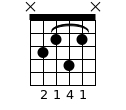 |
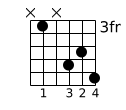 |
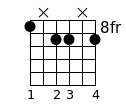 |
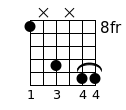 |
Major 7#9
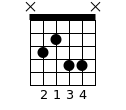 |
 |
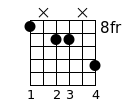 |
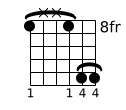 |
Major 7b13
I talks a bit about these in another recent post but here are some more. I've included the 5 in all voicings to make it clear this isn't a Maj7#5 chord; those are interesting too, though.
 |
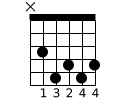 |
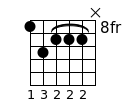 |
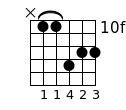 |
Major 7#13
In a way these are the most intriguing to me; they're a simultaneous mixture of both major and dominant chord qualities.
 |
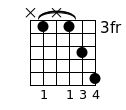 |
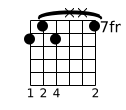 |
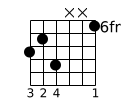 |
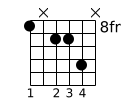 |
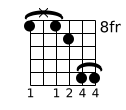 |
Minor Sevenths
The #9 and #13 are ruled out because they coincide with the b3 and b7; the 9, 11 and 13 (=6) are common enough. You would think that adding the b11 would be uncommon but the resulting chord, 1 b3 5 b7 b11, can be respelled 1 3 5 b7 #9 -- that is, the very common 7#9 or "Hendrix chord". So the remaining options to cover are b9, #11 and b13.
Minor 7b9
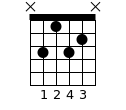 |
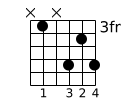 |
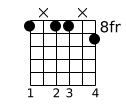 |
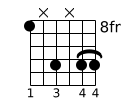 |
Minor 7#11
Here, because #11 = b5, we must make sure to include the 5 so that we don't end up with the much more common half diminished chord. The top note of the first chord is played with the knuckle of the index finger.
 |
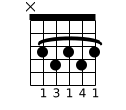 |
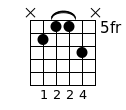 |
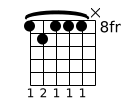 |
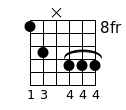 |
Minor 7b13
Again we need the 5 in the chord to avoid it turning into something much simpler -- this time a plain major add 9 chord built on the b13 itself. The third fingering is awkward and again requires the top note to be played with the knuckle.
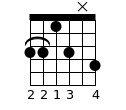 |
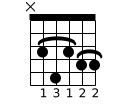 |
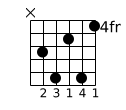 |
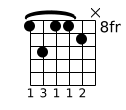 |
Final note: I made the images in this post using Einar Egilsson's brilliant Chord Generator, which is by far the quickest and cleanest way I've found to embed simple chord diagrams in a web page.